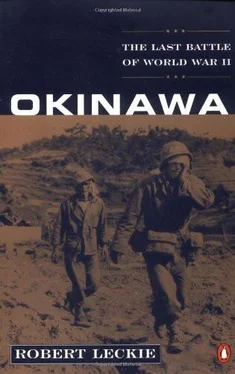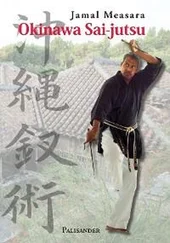Two days later Old Glory was in its rightful place. General del Valle sent a party with the standard of the First Marine Division, the one that had flown over Guadalcanal, New Britain, and Peleliu.
Now, above Shuri Castle not far from the spot where Commodore Perry had hoisted the American flag a century ago, the most victorious flag of the Pacific was caught and flung in the breeze.
The Japanese retreating to the south could see it. They fired on it, missing. They kept firing, for they understood that the terrible power it symbolized was already massing to come south and destroy them.
Chrysanthemums Die in Sea and Sky
CHAPTER TWENTY-TWO
Plane and pilot losses in the Fifth Air Fleet and Sixth Air Army had been so severe that in Japan a special kamikaze corps had been organized. Replacements in both machines and men were fed from bases in central and northern Nippon to Kyushu. Often these aviators were hardly more than raw recruits whose training periods were of short duration. At first the kamikaze had been strictly volunteers, but as the Okinawa campaign continued, all Japanese sailors and soldiers were subject to suicide duty whether or not they wished to go. Sometimes commanders “volunteered” their entire units for this not-always desirable service. More and more “glorious young eagles” began to “get lost” and returned to base. Others who went willingly were frustrated by frequent engine trouble or the weather. These were the ardent, idealist youths such as the pilot who left the verse: “When I fly the skies What a fine burial place Would be the top of a cloud.” Others were not so eager to make the supreme sacrifice, like the one who wrote: “I say frankly, I do not die willingly. I die not without regret. My country’s future leaves me uneasy… I am terribly distressed.”
Much of the glamour of the Special Attack Forces had faded. Its members were still idolized, of course, and there was always a ceremony for the final departure: toasts of sake to be drunk and cigarettes from the Imperial Gift to be smoked—Hirohito’s parting benefaction upon his private army of assassins. But the scourging of the Kyushu bases by American air power had turned these once-thriving and stimulating centers into dreary, dismal limbos where the kamikaze awaiting the death order escaped boredom—or depression—by helping local farmers with their spring planting.
Rain, it seemed, always brought the kamikaze, and on May 11 as the Tenth Army assault slogged and slipped forward, the growl and grumble and whistling rain of the Great Loo Choo’s skies were a welcome sound to about 150 Japanese aircraft hurtling south from Kyushu. Those who were believing Shintoists said a prayer of thanksgiving to the Sun Goddess for having providentially averted her face, forgetting in their gratitude the disaster that had crippled their attack at its outset. A formation of Judy bombers climbing from Kokobu Airfield’s Airstrip 2 crashed into a formation of Val suiciders taking off from another runway, with a total loss of 15 planes. The remaining 135, however, continued to roar south for Okinawa and TF 58.
Those that reached Picket Station 15 about 7:50 A.M. were delighted to sight two enemy destroyers clearly visible below them. They were the Evans and Hugh W. Hadley, commanded by Naval Academy classmates Commanders Robert Archer in Evans and Baron Mullaney in Hadley. They watched in apprehension as no less than 50 suiciders peeled off to begin orbiting above them—and when they began to dive, there ensued probably the classic ship-airplane battle of World War II.
For an hour and a half without letup Evans and Hadley fought off fifty kamikaze. Hadley alone shot down twenty-three of them, while Evans claimed fifteen. The Marines from Yontan and Kadena knocked another nineteen out of the skies. Commander Mullaney of Hadley called for Marines to help him. Back came the squadron leader’s answer: “I’m out of ammunition but I’m sticking with you.” He did, flying straight into a flurry of ten kamikaze coming at Hadley fore and aft, trying to head them off—while other Marines of his squadron rode down through the ack-ack with stuttering guns. They were not always successful, for both of these tough little ships took four kamikaze hits apiece. But they survived to be towed to that anchorage in Kerama-retto that had become a vast hospital ward for stricken and maimed American ships, and there Commander Mullaney could write this tribute to the Yontan and Kadena fliers: “I am willing to take my ship to the shores of Japan if I could have these Marines with me.”
Meanwhile, another fifty kamikaze had found Task Force Fifty-eight. On the bridge of his flag carrier Bunker Hill Admiral Marc Mitscher watched in open admiration as the Japanese pilots skillfully used rain clouds and window to deceive the American radar. He frowned as a Zero suicider broke from low clouds on the carrier’s starboard quarter, smashing through rows of planes on the flight deck to start fires before crashing overboard and exploding. Behind it came a Judy diving straight down from astern. It hit at the worst possible moment—with armed planes refueling on the flight deck. While a broken fuel line fed a roaring fire, these planes exploded like a burst from a giant machine gun. In a few moments 400 sailors were killed or blown out of sight and another 264 wounded.
Even so Bunker Hill’s ordeal did not quite equal the agony of Franklin, although there was just as much heroism in the fight to douse her flames and keep her afloat. Machinist’s Mate Jack Salvaggio would forever bless the porthole in the ship’s stencil room that he had so fervently cursed for the wind blowing through it to scatter his papers. Now he wriggled through this passport to continued life. Another machinist named Harold Fraught believed he was trapped in a smoke-filled passageway, until he saw a tiny open porthole. “I was about to reach it but couldn’t, and I was just about to give up when someone pushed me through. I sure would like to find out who it was who kept pushing every guy through but not saving himself.”
For 5½ hours Bunker Hill’s gallant crew fought the flames threatening to consume and sink their ship. Splendid seamanship saved her: heeling from a list to starboard to one to port, the great vessel gradually combined gravity and gathering momentum to send a huge mass of burning gasoline and oil, water and foam, sloshing slowly from the hangar deck overboard into the sea. At this point, Admiral Mitscher transferred his flag from Bunker Hill —the second-worst-hit ship in the Navy to survive, though she would need many months of repair—to the more famous Enterprise. Next day, the kikusui struck again, but not nearly with as much savagery as on May 11—scoring only one hit on the Bache, a radar picket ship far south of Okinawa, knocking out its power plant and killing forty-one sailors.
Nevertheless Admiral Spruance was alarmed by the renewed fury of the Floating Chrysanthemums and ordered Mitscher to take two task groups north to work over the Kyushu airfields. Mitscher did, introducing a naval novelty in the night-flying Air Group Ninety aboard Enterprise, which gave the weary Japanese airmen no rest. Mitscher also struck hard at Ugaki’s northern airfields, shifting his sights from the enemy’s battered southern bases. Meanwhile, Corsairs and Hellcats ranged among enemy interceptors like devouring wolves while the torpedo-launching Avengers and Helldiver dive-bombers ravaged no less than thirty-four of Ugaki’s air bases.
Still the kamikaze fought back. On May 14 a flight of eighty-four fighters zoomed aloft as cover for twenty-six Zero suiciders bent on punishing TF 58 for its audacious strikes at the homeland. A pretakeoff briefing could not have been briefer: three words, “Get the carriers!” Young Lieutenant Tomai Kai could not forget this command as he roared aloft in his bomb-laden Zero. To his delight he soon found himself above TF 58 and a monster carrier. He had no way of knowing that this was Enterprise —the “Big E, ” one of the most battle-seasoned flattops of World War II—but he didn’t hesitate to jump her despite the bucking and bouncing of his frail craft from enemy ack-ack exploding around him. Bursting from a cloud at fifteen hundred feet, Kai pointed his Zero’s nose at the Big E’s stern and opened his throttle, miraculously passing unscathed through a storm of 20 and 40 mm tracers flowing toward him. Standing on the carrier’s bridge Admiral Mitscher’s calculating eye calmly watched the enemy’s approach.
Читать дальше










